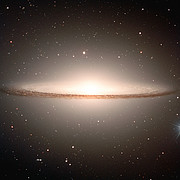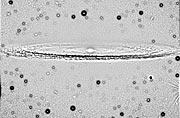Nota de Imprensa
Fine Shades of a Sombrero
A New Look at an Unusual Galaxy
23 de Fevereiro de 2000

Acknowledgments: Mark Neeser (Kapteyn Institute, Groningen) and Richard Hook (ST/ECF, Garching, Germany). )
In addition to their scientific value, many of the exposures now being obtained by visiting astronomers to ESO's Very Large Telescope (VLT) are also very beautiful. This is certainly true for this new image of the famous early-type spiral galaxy Messier 104, widely known as the "Sombrero" (the Mexican hat) because of its particular shape.
The colour image was made by a combination of three CCD images from the FORS1 multi-mode instrument on VLT ANTU, recently obtained by Peter Barthel from the Kapteyn Institute (Groningen, The Netherlands) during an observing run at the Paranal Observatory. He and Mark Neeser, also from the Kapteyn Institute, produced the composite images.
The galaxy fits perfectly into the 6.8 x 6.8 arcmin 2 field-of-view of the FORS1 camera. A great amount of fine detail is revealed, from the structures in the pronounced dust band in the equatorial plane, to many faint background galaxies that shine through the outer regions.
The "Sombrero" is located in the constellation Virgo (the Virgin), at a distance of about 50 million light-years. The overall "sharpness" of this colour image corresponds to about 0.7 arcsec which translates into a resolution of about 170 light-years at that distance.
About Messier 104
Messier 104 is the 104th object in the famous catalogue of nebulae by French astronomer Charles Messier (1730 - 1817). It was not included in the first two editions (with 45 objects in 1774; 103 in 1781), but Messier soon thereafter added it by hand in his personal copy as a "very faint nebula". The recession velocity, about 1000 km/sec, was first measured by American astronomer Vesto M. Slipher at the Lowell Observatory in 1912; he was also the first to detect the galaxy's rotation.
This galaxy is notable for its dominant nuclear bulge, composed primarily of mature stars, and its nearly edge-on disk composed of stars, gas, and intricately structured dust. The complexity of this dust, and the high resolution of this image, is most apparent directly in front of the bright nucleus, but is also very evident as dark absorbing lanes throughout the disk. A significant fraction of the galaxy disk is even visible on the far side of the source, despite its massive bulge, c.f. ESO Press Photo eso0007c.
A large number of small and slightly diffuse sources can be seen as a swarm in the halo of Messier 104. Most of these are globular clusters, similar to those found in our own Galaxy.
Measurements reveal a steep increase in the mass-to-light ratio and increasing stellar speeds near the nucleus of Messier 104 . This is indicative of the presence of a massive black hole at the centre, estimated at about 10 9 solar masses.
The radio properties of Messier 104 are unusual for a spiral galaxy -- it has a variable core. The optical spectrum of the central region displays emission lines from hot gas (of the "LINER" type -- Low Ionisation Nuclear Emission line Region). This points to Messier 104 harbouring a weak Active Galactic Nucleus (AGN) . Although more commonly known from the much more luminous and distant quasars and powerful radio galaxies, the weak AGN in this galaxy lies at the opposite extreme: the most likely explanation being a central black hole accreting circumnuclear matter at a slow pace.
Sobre a Nota de Imprensa
| Nº da Notícia: | eso0007 |
| Legacy ID: | Photo 07a-c/00 |
| Nome: | M 104, Messier 104, Sombrero Galaxy |
| Tipo: | Local Universe : Galaxy : Type : Spiral Local Universe : Galaxy : Activity : AGN |
| Facility: | Very Large Telescope |
| Instrumentos: | FORS1 |
Our use of Cookies
We use cookies that are essential for accessing our websites and using our services. We also use cookies to analyse, measure and improve our websites’ performance, to enable content sharing via social media and to display media content hosted on third-party platforms.
ESO Cookies Policy
The European Organisation for Astronomical Research in the Southern Hemisphere (ESO) is the pre-eminent intergovernmental science and technology organisation in astronomy. It carries out an ambitious programme focused on the design, construction and operation of powerful ground-based observing facilities for astronomy.
This Cookies Policy is intended to provide clarity by outlining the cookies used on the ESO public websites, their functions, the options you have for controlling them, and the ways you can contact us for additional details.
What are cookies?
Cookies are small pieces of data stored on your device by websites you visit. They serve various purposes, such as remembering login credentials and preferences and enhance your browsing experience.
Categories of cookies we use
Essential cookies (always active): These cookies are strictly necessary for the proper functioning of our website. Without these cookies, the website cannot operate correctly, and certain services, such as logging in or accessing secure areas, may not be available; because they are essential for the website’s operation, they cannot be disabled.
Functional Cookies: These cookies enhance your browsing experience by enabling additional features and personalization, such as remembering your preferences and settings. While not strictly necessary for the website to function, they improve usability and convenience; these cookies are only placed if you provide your consent.
Analytics cookies: These cookies collect information about how visitors interact with our website, such as which pages are visited most often and how users navigate the site. This data helps us improve website performance, optimize content, and enhance the user experience; these cookies are only placed if you provide your consent. We use the following analytics cookies.
Matomo Cookies:
This website uses Matomo (formerly Piwik), an open source software which enables the statistical analysis of website visits. Matomo uses cookies (text files) which are saved on your computer and which allow us to analyze how you use our website. The website user information generated by the cookies will only be saved on the servers of our IT Department. We use this information to analyze www.eso.org visits and to prepare reports on website activities. These data will not be disclosed to third parties.
On behalf of ESO, Matomo will use this information for the purpose of evaluating your use of the website, compiling reports on website activity and providing other services relating to website activity and internet usage.
Matomo cookies settings:
Additional Third-party cookies on ESO websites: some of our pages display content from external providers, e.g. YouTube.
Such third-party services are outside of ESO control and may, at any time, change their terms of service, use of cookies, etc.
YouTube: Some videos on the ESO website are embedded from ESO’s official YouTube channel. We have enabled YouTube’s privacy-enhanced mode, meaning that no cookies are set unless the user actively clicks on the video to play it. Additionally, in this mode, YouTube does not store any personally identifiable cookie data for embedded video playbacks. For more details, please refer to YouTube’s embedding videos information page.
Cookies can also be classified based on the following elements.
Regarding the domain, there are:
- First-party cookies, set by the website you are currently visiting. They are stored by the same domain that you are browsing and are used to enhance your experience on that site;
- Third-party cookies, set by a domain other than the one you are currently visiting.
As for their duration, cookies can be:
- Browser-session cookies, which are deleted when the user closes the browser;
- Stored cookies, which stay on the user's device for a predetermined period of time.
How to manage cookies
Cookie settings: You can modify your cookie choices for the ESO webpages at any time by clicking on the link Cookie settings at the bottom of any page.
In your browser: If you wish to delete cookies or instruct your browser to delete or block cookies by default, please visit the help pages of your browser:
Please be aware that if you delete or decline cookies, certain functionalities of our website may be not be available and your browsing experience may be affected.
You can set most browsers to prevent any cookies being placed on your device, but you may then have to manually adjust some preferences every time you visit a site/page. And some services and functionalities may not work properly at all (e.g. profile logging-in, shop check out).
Updates to the ESO Cookies Policy
The ESO Cookies Policy may be subject to future updates, which will be made available on this page.
Additional information
For any queries related to cookies, please contact: pdprATesoDOTorg.
As ESO public webpages are managed by our Department of Communication, your questions will be dealt with the support of the said Department.


